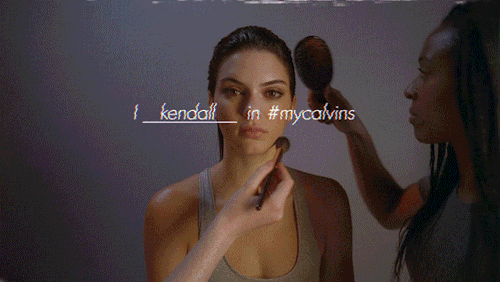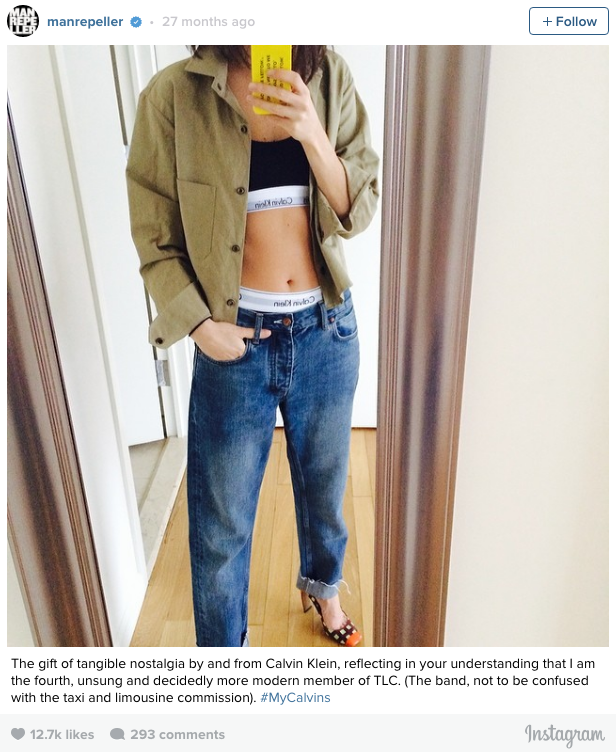I _____ in #mycalvins Campaign:
An example of millennial marketing done well.
As a co-founding member of the National Millennial Community who assists top executives from corporations like Coca-Cola, IBM or PUMA to help them better understand the needs, interests and aspirations of the millennial generation, people often ask me: what do you consider an example of a successful marketing campaign to millennials?
There are many cases that come to mind, such as Bud Light’s “Up for Whatever” Campaign. But one that cannot be missed as an primary example of millennial marketing done right is Calvin Klein’s #inmycalvins Campaign, as clearly proven by its wild success.
Calvin Klein is a brand that, with this campaign, demonstrates that it just gets millennials. But what is the secret to millennial marketing success? Let’s explain by unpacking this amazing campaign.
First of all, what needs to be mentioned and what I often discuss with these executives is that marketing strategies that have been developed when Baby Boomers were young adults are no longer applicable to millennials. For example, the AIDA model (that stands for Awareness, Interest, Desire and Action) which has been the foundation for brand campaigns for the past decades just does not work well for the most digitally driven population of consumer to date. And this is something many companies still fail to understand. Why do they not work anymore? Because they were created in order to appeal to a very linear path to purchase. Millennials, however, do not function in a linear way, because their constant digital and mobile engagement allows them to interact with brands more directly and at a faster rate than ever before.
Calvin Klein, however, has understood this shift very well and has already adapted a new way of thinking in how it markets to consumers. With this campaign, it won millennials over because it threw out the window the old AIDA model and instead focused on creating a brand that is alive, dynamic and thriving. It used a new model that looks much more like this, what some call “the Brand Atom Model.”
Let’s break down this model to better understand how it works and how it explains why Calvin Klein’s campaign was a wild success in marketing to millennials.
In the center of the model, we have the so-called “ENERGY” that surrounds the campaign.
The "Energy" is the center of the model, absolutely crucial to the success of the any millennial marketing campaign, and whether this energy is generated depends on it developing 2 things: positive word-of-mouth & positive word-of-mouse.
Let’s start with positive word-of-mouth.
Why is it important? Because millennials do not care nor trust what a brand says about itself. Instead, they trust and care about what “real people” have to say, meaning friends, family, peers and even random strangers. Just think about it. We live in an age where people trust what a random person they don't know says on their review on TripAdvisor much more than what an official review company like Zagat or the business that is being reviewed itself have to say.
As Suzanne Fanning, President of Word of Mouth Marketing Association, put it very well: “Millennials are the most connected generation of buyers the world has ever seen, but they don’t trust companies or CEOs – they trust their friends and connections, and they want to hear about real experiences from real people.”
This means that, as a brand, you should not focus as much on what you say about yourself, but rather on trying to get others to talk for you.
The first step is, thus, that you have to make sure your customers are happy and satisfied, so that they will positively talk for themselves.
The second step, since these millennials trust and want to hear real opinions from real people, is to ensure that you provide them with easy ways for them to share these opinions, which gets to my second point: generating positive word-of mouse.
In short, get people to talk about you, share your content and spread awareness.
Focusing on generating word-of-mouth and word-of-mouse is exactly what Calvin Klein did with this campaign.
Calvin Klein understood that an unpaid, authentic posts by a friend endorsing a brand is more powerful to young people than obviously paid-for influencer posts, a print ad, or a celebrity endorsement.
That is why it first generated positive word-of-mouth by carefully selecting top millennial influencers such as Kendall Jenner and Justin Bieber, encouraging them to share their own #inmycalvins posts in an authentic, natural way.
In this first step, brands must be extremely careful because millennials are quick to catch on and critical when a brand isn’t being authentic - or - trying too hard. But what Calvin Klein did was adjust their strategies to speak to millennials without overhauling their entire look and voice. This campaign tied together young millennial passions, interests, and beliefs in perfect harmony, while still staying true to their brand. The campaign’s content was authentic, non-disruptive, and looked like the type of content a young millennial would create themselves. And guess what… they did create it because, after they created positive millennial opinions through the popular influencers, they not only gave customers an easy way to not share their opinions on social media through the #inmycalvins hashtag, but they also invited them to be a part of the campaign themselves by encouraging customers to create and share their own personal content with their own personal and customized "I____ #inmycalvins" caption.
This hits right in the heart of millennials because if there are 2 things that millennials want is to:
1. Millennials want to be brand partners, not just brand customers.
2. Millennials want personalized, tailor-made content that gives them a chance to express their individuality.
In this way, Calvin Klein clearly created a campaign that is based on a PARTNERSHIP between the Calvin Klein brand and Calvin Klein fans / customers. It is this partnership is the piece that holds the entire model together.
Millennials do not want to be your customer, they want to be your brand partner. They want to engage and co-create with the brand. Calvin Klein gets that and that is exactly why, through this campaign, it tells millennials that they are a vital part of the campaign and a crucial partner to the brand. Without them filling in the blank between “I and #mycalvins” and sharing their personal content, the campaign means nothing. This makes millennials feel valued, and consequently they then value the brand for: giving their customers their a voice, and for counting on them to be a vital part of the creation process and of the brand. With this campaign, they have successfully allowed for millennials to take ownership of your product and/or brand and turns them into brand ambassadors, not just customers. What is more, the blank space that needs to be filled in between I and #mycalvins leaves room for the imagination, and makes millennials INTRIGUED. They do not know what to expect, and the intrigue and the invitation to imagine and guess ultimately motivates them to participate in filling in the blank themselves.
Moreover, millennials do not want one-size-fits all. They want and expect customized content, products and services that talks directly to them, and that provides them with opportunities to express their individuality. When Millennials were young—as with teens in previous generations—it was all about fitting in. They wore Abercrombie and Nike. They flocked to see the Spice Girls and N’Sync en masse. But no more. Today, more than any other generation, millennials desire to be seen as unique within a group. Once mad for popular brands like Tommy Hilfiger, now a majority of millennials reject trends to develop their own personal clothing style and favor companies and brands that provide them with ways to express their real, authentic and individual selves.
Through this opportunity to co-create with the brand and share their own personalized content in their calvins, millennials shared in an EXPERIENCE, not just with the brand, but also with each other.
Calvin Klein also realizes the value millennials place on experiences, and invited millennials to go create and define their own experiences "in their calvins," instead of defining their experiences for them - as many brands do.
But these experiences are not just about showing yourself in your underwear. It is about giving millennials value and MEANING. It is about being brave to show and express your real self, about being part of a community that encourages you to be authentic and different, and about connecting & building real relationships with people who like you for who you are.
To top it all of, the campaign touched on NOSTALGIA with the hashtag language refercing the iconic 1981 television ad for Calvin Klein Jeans that featured teenage Brooke Shields whispering "You wanna know what comes between me and my Calvin's? Nothing." In this way, CK leveraged the brand’s successful past, making it an important component of its present campaign.
Overall, Calvin Klein knocked it out of the park when it came to engaging millennial consumers with this campaign, as proven by its 451,601 photos on Instagram tagged #MyCalvins. The future of marketing relies on campaigns like Calvin Klein's that recognize that brands are no longer a static entity but instead are living and breathing organisms.
And this is what we call an example of millennial marketing done very, very well.












